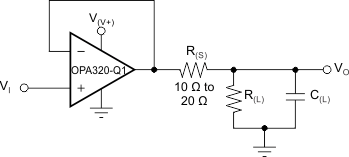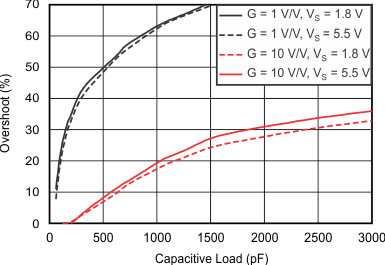ZHCSCS6B September 2014 – December 2018 OPA2320-Q1 , OPA320-Q1
PRODUCTION DATA.
7.3.5 Capacitive Load and Stability
The OPAx320-Q1 are designed to be used in applications where driving a capacitive load is required. As with all op amps, there may be specific instances where the OPAx320-Q1 can become unstable. The particular op amp circuit configuration, layout, gain, and output loading are some of the factors to consider when establishing whether an amplifier is stable in operation. An op amp in the unity-gain (1 V/V) buffer configuration and driving a capacitive load exhibits a greater tendency to become unstable than an amplifier operated at a higher noise gain. The capacitive load, in conjunction with the op amp output resistance, creates a pole within the feedback loop that degrades the phase margin. The degradation of the phase margin increases as the capacitive loading increases. When operating in the unity-gain configuration, the OPAx320-Q1 remain stable with a pure capacitive load up to approximately 1 nF.
The equivalent series resistance (ESR) of some very large capacitors (C(L) > 1 µF) is sufficient to alter the phase characteristics in the feedback loop such that the amplifier remains stable. Increasing the amplifier closed-loop gain allows the amplifier to drive increasingly larger capacitance. This increased capability is evident when observing the overshoot response of the amplifier at higher voltage gains; see Figure 32. One technique for increasing the capacitive load drive capability of the amplifier operating in unity gain is to insert a small resistor (R(S)), typically 10 Ω to 20 Ω, in series with the output, as shown in Figure 31.
This resistor significantly reduces the overshoot and ringing associated with large capacitive loads. A possible problem with this technique is that a voltage divider is created with the added series resistor and any resistor connected in parallel with the capacitive load. The voltage divider introduces a gain error at the output that reduces the output swing. The error contributed by the voltage divider may be insignificant. For instance, with a load resistance, R(L) = 10 kΩ and R(S) = 20 Ω, the gain error is only about 0.2%. However, when R(L) is decreased to 600 Ω, which the OPAx320-Q1 are able to drive, the error increases to 7.5%.
 Figure 31. Improving Capacitive Load Drive
Figure 31. Improving Capacitive Load Drive  Figure 32. Small-Signal Overshoot versus Capacitive Load (100-mVPP Output Step)
Figure 32. Small-Signal Overshoot versus Capacitive Load (100-mVPP Output Step)